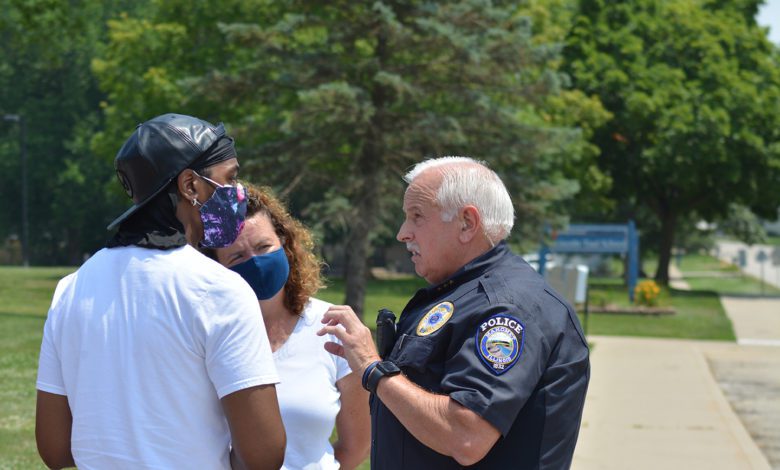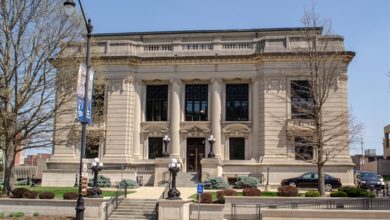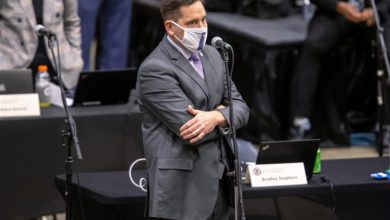First 20 minutes of Mahomet BLM protest sets tone for march

For more photos of this event, visit https://mahometdaily.smugmug.com/July-Paign-to-Peace-March-Mahomet/.
Prior to 1 p.m. on Wednesday, July 8, both ‘Paign to Peace protesters and the Mahomet Police Department felt like they were on the same page.
But at 1 p.m., while standing in the parking lot of Lincoln Trail Elementary School in July heat, it became obvious that the two groups envisioned a two-hour march that covered residential streets in the heart of Mahomet in very different ways.
‘Paign to Peace, a group of young adults from Champaign-Urbana, released the route of the “My Culture is not a Trend” protest via Facebook on July 4.
The original route took the march down highly visible and heavily trafficked areas of Lombard (IL-47), Franklin, Oak (IL-150), Elm and Jefferson streets. Being able to stop at high-profile areas has been a common practice for ‘Paign to Peace. The group held an 8-mile protest in June in Champaign that included stops and walks along Kirby, Prospect, Bradley and University.
Although it is not a law that protesters alert municipalities or law enforcement of the intent to protest, Mahomet Police Chief Mike Metzler reached out to ‘Paign to Peace in the afternoon on July 6 in an attempt to talk to the organizer, Naomi DuPree, a recent graduate from Central High School.
Near the same moment, ‘Paign to Peace reached out to the Mahomet Police Department, according to an account by Metzler.
“I spoke with Ms. DuPree by telephone,” Metzler said. “She apologized for not contacting anyone with the Village. I explained that the published route involved two very busy state highways that would pose significant safety concerns. I also mentioned that the route would also impact Cornbelt (Fire Department’s) ability to come and go from their facility.
“Ms. DuPree told me she had worked with Chief Cobb in planning an 8-mile march in Champaign, with stops at various intersections for speeches. Ms. DuPree wanted to do something similar in Mahomet, with a much shorter route.
“She told me the route she had originally planned was about a mile long. She wanted to stop at intersections along the way for about 15-minutes each and have different speakers tell their stories.
“I explained that Mahomet did not have the same amount of resources that Champaign could offer and I wanted to ensure that we could provide for the protesters’ safety.”
Upon Metzler’s request to find an alternative route similar to the one used for the Mahomet Music Festival and Mahomet-Seymour Homecoming Parade, DuPree agreed.
“I told her I was more than willing to work with her to ‘provide a safe and productive atmosphere,’” Metzler said.
Less than 10 minutes after the exchange, Metzler heard back from DuPree, saying that route, one that left and returned at Lincoln Trail, heading down Division, Main, Center, State, Elm and Dunbar “works for me!”
Metzler and DuPree planned to meet up in-person the next morning to finalize the details.
“Shortly after 9 a.m., I texted Ms. DuPree, asking where she would like to meet. She responded about 40 minutes later and we ultimately agreed to meet at Panera’s in Champaign at 10:30 a.m. I arrived at the meeting prior to 10:30 a.m. Ms. DuPree arrived about 10:50 a.m.” Metzler recalls.
According to Metzler, DuPree said that she was not concerned with visibility, but rather time to listen to their message during the march.
“Ms.DuPree told me their intention was to stop and educate people about the theme of the march, “My Culture Is Not A Trend.” She told me that Mahomet was not on the radar for a protest anytime soon, but people from Mahomet had reached out and demanded something be done because of some “viral videos.”
“I expressed concern about stopping in intersections for 15 minutes at a time. She agreed to limit stops to 10 minutes each and mentioned she would have a timer. She also settled on six different intersections, making sure that each leg of the route had a stop.”
It has also been an established practice in ‘Paign for Peace marches that the group have a few vehicles with them: a vehicle for a speaker system to project their voices during the 10-15-minute stops along the route, water and medical supplies, and a place for protesters to find respite along the route.
Metzler also asked ‘Paign for Peace to fill out a Village of Mahomet special event request form and event name, DuPree indicated that she estimated about 100-200 participants, that they would need police patrols and traffic control and that the event would be considered a “parade” with “floats, participants.”
The Village of Mahomet does not have a resolution or ordinance associated with special events.
The ACLU cites that protesters have the “strongest” rights when they use “‘traditional public forums,’ such as streets, sidewalks, and parks.” Public property, such as plazas in front of government buildings, should also be accessible to protesters as long as they “are not blocking access to the government building or interfering with other purposes the property was designed for.”
The ACLU also states that protesters may need a public permit if “a march or parade requires blocking traffic or street closure; a large rally requiring the use of sound amplifying devices; or a rally over a certain size at most parks or plazas.”
Village Administrator Patrick Brown said that the group was asked to fill out the permit because it is “unlawful to block streets or walk in the street and impede traffic.”
The permit gives local municipalities notice so that they can coordinate with police, fire and public works departments.
Metzler shared with local leaders, including John Koller, Cornbelt Fire Department Chief, Master Sergeant for Illinois Department Of State Police Ryan Starrick, Village Administrator Patrick Brown, Village President Sean Widener, Mahomet-Seymour Superintendent Lindsey Hall and Village Streets/Maintenance Department Superintendent Jim Barden.
Brown indicated that the Village does not define parades (floats, participants) because he thinks it is “logically obvious.”
“I don’t think anyone would define a march as anything but people walking in it. This was not a parade and never planned as a parade,” he said.
Yet, at 1 p.m. on July 8, a discussion about cars being allowed in the march, ensued and escalated.
Mahomet resident Michelle Matthews watched the moment unfold.
“I was standing in the parking lot, not far from where the Paign to Peace organizers were standing,” Matthews said. “I watched Chief Metzler approach them and begin to speak to them. I assumed he was providing final instructions about where to line up and other specifics pertaining to the march. I heard the voice of Chief Metzler begin to increase in volume, and then I heard some of the organizers’ voices begin to increase in volume in response. I could not make out what was being said initially until I got closer, but I could hear they were discussing the permit for the march.
“I heard Chief Metzler tell them they could not include any vehicles in the march. This was not what had originally been discussed and agreed upon.”
The Village and Mahomet Police Department said that they never considered or discussed vehicles in the march.
“Chief Metzler tried to say that he was concerned about the ‘safety’ of the protesters who would be in the roadway with ‘Paign to Peace’s vehicles,” Matthews said. “At that point, I stepped in and asked him how Mahomet’s annual homecoming parade was any different than the event we were attending, and I brought up the following points: during homecoming, vehicles and pedestrians share the roadway. The homecoming king and queen sit in the convertible, not seat-belted in, half-hanging out of the car to wave at everybody. Football and volleyball teams are sitting/standing unsecured on flat-bed trailers, being pulled by pick-up trucks. In front of them walks the marching band, dance team, and cheerleaders, all performing in the streets. ‘Safety’ isn’t a concern for our annual homecoming parade. Why is this event different?”
Matthews said that Metzler cited that the original permit did not state that vehicles would be included in the event. When Matthews asked if the permit stated that claim, Metzler said that he didn’t know or have a copy with him.
This was around 1:15 p.m.
Metzler felt that the event was to begin at 1 p.m., but ‘Paign to Peace organizers say that the march was to begin at 1:30. Metzler asked to talk to DuPree, who arrived at 1:20, but was available to talk to the Chief of Police on the phone. Metzler walked away from the group when they stated he could talk to her.
Instead, Metzler talked to ‘Paign to Peace mentor Justin Hendrix. Spectators say that at one point during the conversation, Metzler put his hands on Hendrix. Metzler said he does not remember doing this.
Metzler wanted to put the ‘Paign for Peace supplies in the Mahomet Police Department’s vehicles. He then wanted to lead and follow the ‘Paign for Peace vehicles throughout the route.
Hendrix shared that the vehicles had been used in other protests in Champaign County without hesitation or problem, citing that they were not only for supplies, but also for the protesters’ protection. ‘Paign for Peace wanted to hold the event in the middle of the day because, as people of color, they did not feel safe in the Village during the evening hours.
“After ‘Paign To Peace co-leaders and co-organizers questioned Chief Metzler on why he would not allow us to have the cars, and how else we would carry our supplies, his response was that ‘His people would be at the intersections,’” ‘Paign to Peace organizers said.
Near 1:30, Metzler withdrew his requests, allowing the vehicles to proceed with the marchers, saying that passengers could not sit on top of the vehicles or that the vehicle could not come into the area where the marchers were on the street.
Hendrix said that he had witnessed other parades in Mahomet where passengers were sitting on roofless cars or on flatbeds, but assured the Chief that the passengers would stay in the vehicle.
Protesters voiced their concerns for safety, too.
The Police Chief, standing closer than six-feet from individuals, was not wearing a mask.
“It should be noted that he, along with every other Mahomet officer he brought as ‘backup,’ were not wearing masks or socially distancing themselves from us or any of the other protesters,” ‘Paign to Peace organizers said. “Upon being offered masks kindly by volunteers, Paign To Peace organizers and community members, the officers refused every time and continued to approach us, touching some of our ‘Paign To Peace members, and other protestors with seemingly no regard to the current pandemic. As many Mahomet community members pointed out, as well as co-leaders from our team, Chief Metzler and the Mahomet polices’ decision to not wear a mask directly threatened the health of not only protestors but Mahomet citizens – those that Chief Metzler claimed he was aiming to ‘protect.'”
They were also very aware of the amount of police officers needed to make sure a group much smaller than was present at a Mahomet march in early June that walked from the Village Administration building to the Mahomet Police Department could walk around a residential area of Mahomet.
“Just driving into the small town of only 8,000 people, there were six or more police cars around the area we were starting our march, in addition to Mahomet officers that were brought in later on,” organizers wrote.
“For reference, ‘Paign To Peace held a Black Lives Matter Protest in Champaign Urbana back in June, and although thousands of protestors showed up, and the route was 8 miles, there were only a few police cars and no police interaction.
“What happened in Mahomet was unprecedented over-policing of a small protest with maximum 100 protestors. We believe that without Chief Metzler’s over-policing of our event, it would have gone smoothly, like the rest of our protests in the past.”
Matthews, who had been to several ‘Paign to Peace protests, also said there were very few police officers in Champaign-Urbana. She said that she believes the Mahomet Police Department could have provided a safe environment for the protesters and bystanders marching on residential streets in Mahomet.
“I feel fairly confident that if the Champaign Police Department can manage the logistics of blocking off most of Champaign for half a day, the Mahomet Police Department could replicate their strategies for the two-hour march,” Matthews said
The Mahomet native who raised her daughter in Mahomet led the marchers, alongside Paul Saban of Sages for Solidarity.
“I wanted to make sure that those who were watching the protest from their cars, porches, and doorsteps saw that it was not just outsiders who came in to cause trouble,” Matthews said. “We are community members who are actively engaged in fighting racism, in all its forms.
“I also am aware that as a white person in a mostly white town, I have privileges that I can use to benefit the group.”
Police officers and Village workers were stationed at many intersections along the route, blocking off traffic as protesters approached, then removing barricades when protesters passed.
As protesters came up to scheduled stops, the back car with ‘Paign to Peace separated the crowd. One organizer can be heard saying that the car that was not being used as a speaker station was being used to stop traffic in front of the protesters where there were no barricades.
Mahomet’s Suzie Jackson, the first speaker, shared her experiences as a mother of bi-racial children since moving to the Village.
“My family and I moved here from a very culturally different town. It was a bigger city, you only occasionally ran into someone you knew, there was more traffic, and people just moved faster,” Jackson said.
“Most differences between these two communities are benign and both communities have added value to our family. However, one difference we still struggle with is that in our previous community it was culturally unacceptable to use racial slurs, to tell racist jokes, or to prioritize your feelings about someone’s experience over their actual experience. Don’t get me wrong, there was racism in our last community. My husband and I were actually victims of unfair housing practices when we were first married and prejudice and ignorance were present, but they were always met with direct correction, conversation and education.
“In our previous home, neighbors talked about race, ethnicity and inclusion, our schools tirelessly trained their teachers and actively taught about the inequities in our community. As kids developed their racial, ethnic, and gender identities, they were encouraged to share their experience, celebrate their uniqueness and value the experiences of others. As a larger community we shared in cultural celebrations of all kinds and were proud of our ability to learn from and value each other.”
Jackson said she wanted to also share that she has experienced wonderful, welcoming people in the Mahomet community. She said she “believes that there are a lot of people who live here who want an inclusive and diverse community.”
“Mahomet has not done the work to change these patterns and shift this culture so racist beliefs have flourished here. Our larger structures (village practices, the absence of training and anti-racism teaching in our schools, a belief that ‘these things don’t happen here’) have allowed racism to take root in our fabric and we need a lot of work to chip away at that.”
‘Paign to Peace Protesters took the microphone at the next two stops.
Organizers talked about why they brought a protest to Mahomet.
Their voices were united against racial slurs, discrimination among race and sex and using the black culture for benefit.
“I don’t understand why we keep having to remind you,” DuPree said.
She talked about how for centuries the Black community has tried to educate White people on blackface, jokes and honoring Black features. She also said that there comes a point when enough is enough.
“The best way for us to handle the situation is education but how much should we educate you? How many times do we have to tell you before you’re held accountable for what you do?” DePree asked.
Organizer Ayan Harris, an incoming senior at Centennial High School, asked for her body and culture back.
“Dear white people, I’m going to need my skin back, my hair back, my nails back and my fashion back,” Harris said. “Matter of fact, I’m gonna need everything you didn’t get one unworthy for black women to have, and perfect for white women to have.
“Why do you love my culture, but hate me? I’m more than your aesthetic. I’m more than your Halloween costume. I’m more than your TikTok dances and your new slang. I am a Black woman.”
Rounding the corner of Jefferson and State street, the leadership of Matthews, Saban and Hendrix made way for protesters where officers were absent.
“Myself, Paul Saban, and several others on bicycles helped to block off intersections along the way, to ensure the safety of the black and brown lives, which were more likely to be harmed at intersections,” Matthews said. “Several intersections were left unmanned and unbarricaded by Mahomet police department. Three different cars from outside of the march were able to enter the roadway, at three different locations along the march. At one point, we had to carry the barricades ourselves, from one intersection to the next. I am just glad that the community members who came out and threatened, intimidated, and taunted the group in the church parking lot were not in their vehicles, at those unmanned intersections, when we marched through them.”
Cops were gathered in front of the State and Division intersection, though. Lined with vehicles, the intersection was blocked.
Metzler said that the mile loop was the end of the agreed upon route while ‘Paign to Peace said they still had another half-hour in the agreed upon time.
As protesters chanted “Where’s your mask,” they circled around the ‘Paign to Peace SUV to hear another message.
Isabela Lleras, an incoming senior at Urbana Uni High School who is also the daughter of a first-generation Columbian immigrant, a White-passing person, talked about white privilege.
Lleras said that white privilege affords white people the opportunity to not fear police officers when pulled over, but racism is also more subtle than that.
She talked about the “new” blackface, where white people will wear shades of makeup much too dark for their skin.
Allyson Godbolt, a recent University of Illinois graduate, also talked about blackfishing, a trend where people alter their appearance in order to present themselves as black. Lleras talked about how the Kardashians do this.
With the appearance of being racially ambiguous while still wanting to come across as a Black person, Godbolt said White people often take advantage of the misconception, using the n-word or to profit off of it.
Tatiana Ammons, an Urbana resident running for County Board in District 11, said, “This generation, we ain’t for none. We ain’t for none on all levels. You want to take it to the streets, we’ll beat you there; you wanna take it to the polls, we’re gonna beat you there; you wanna take it to the City Council or the County Board, we gonna beat you there.
“It’s this generation that is going to make the change.”
At about 2:30 p.m., organizers stated they still had another half-hour to protest while Metzler held to the agreed upon route being complete. Protesters were ready to move again, heading to the police station, located at Oak and Center Street, a 15-minute walk from Lincoln Trail.
Metzler told protesters that they could no longer block traffic flow on Mahomet streets; if they were to continue they could walk on the sidewalks.
“After the permitted event, there were numerous traffic and other violations,” he said. “Protesters do not have a First Amendment right to block pedestrian or vehicle traffic beyond the agreed upon route. There have been court decisions affirming that position.”
Protesters held that they had a First Amendment right to continue to protest, even without a permit. Walkers agreed to walk on the sidewalk to the police station. Metzler stood in front of the ‘Paign to Peace SUV that was still in the center of Division and State.
“In the current climate where federal legislation allows protesters to freely congregate in the streets, it seemed the officers deemed the speed of traffic more important than the murders of black and brown people,” ‘Paign to Peace organizers wrote.
“A number of participants told me that they intended to continue to march down Division to the police department,” Metzler recalled. “I informed them that the permitted march had concluded and that they would no longer be allowed to disrupt traffic by walking down the street. I explained that the marchers were welcome to walk to the police department and rally in our parking lot, but they would have to stay on the sidewalks. I was told the ‘protection’ vehicle needed to accompany the group. I explained that they could proceed to the station, but vehicles would have to stay in the proper lanes of traffic. I placed one of our squads in front of the group as they proceeded south. The group did not follow my instructions and continued to obstruct traffic.”
‘Paign for Peace also told Metzler that their vehicle had the right to be on the road, just like every other vehicle. Once Metzler moved from the front of the vehicle, protesters walked on the sidewalks while a line of cars drove nearby.
The Mahomet Police, Illinois State Police (who did wear face masks) and Village of Mahomet crews stopped traffic on IL-150 as protesters crossed the street and entered into the parking lot.
Along the route, and especially once protesters reached the police station, cursing towards officers and white people, in general, was witnessed and recorded as ‘Paign for Peace shared live video on Facebook.
Matthews affirms that this happened, but offered her perspective.
“Many residents have seen videos that show angry people, shouting and using profanity, sometimes directed toward Chief Metzler and Mahomet’s other officers,” she said. “Yes, these things happened. You witnessed the aftermath. You witnessed their reactions to being provoked. You witnessed their reactions to having their voices silenced by the Chief of Police before the protest could even start. Imagine for a moment that you are trying to peacefully protest inequality, injustice, and unnecessary use of force by law enforcement, and those very same people are at the protest, instigating and antagonizing protesters.”
Hendrix, rattled from the event, shared his message of respecting and honoring the black culture, especially black women.
“I’m here about using your solidarity, to solely focus on the upbringing of black culture, black women and black girls; you must protect, provide and promote,” he said.
“You’ve got to learn to leave the table when love is no longer being served; and black women, and black girls are not being served.
“I think women at large play a major role in opening the doors for better understanding around the world.
“This is not a political statement, or a political weapon. Last time I checked, Black Lives Matter has nothing to do with politics, but you insert the government into black lives.
“This is a wave, a way to move the audience to make them conscious of what has been done to black women and black girls around the world. You don’t have to live near a black woman or a black girl to give them their share of equity and equality: that means social services, employment, politics, socio economics, academics.”
‘Paign to Peace also talked about wanting to abolish law enforcement agencies across the country, directing those funds to community resources and programs.
Jackson said she enjoyed listening to the young speakers.
“There were many points where I felt overwhelmed by the power and pain of the experiences of the organizers and speakers,” she said. “I did not feel scared for myself, but I did feel scared for the young people who were fighting for space to express their frustration. It was embarrassing to see how they were treated by our community. It was clear from the beginning that the protest was not supported.
“I was glad I attended and did gain a better understanding of the “new black face” when several of the speakers talked about how it feels to see other races use aspects of their culture (like music, dress, and language) but continued to be denied access to resources like fair treatment by police, quality education, jobs and housing. It was powerful to hear these young people bravely call out this issue in a place where they did not feel safe.”
Jackson would now like to see action taken by the Mahomet-Seymour School District, Village of Mahomet board and the Mahomet Police Department.
She asked for them to release statements about their values, beliefs about race, equality and inclusion.
“I would like to see these institutions live by those beliefs in the things they teach, the vendors they allow at our festivals, the symbols in our parades and public spaces and the way they welcome others to our village,” she said. “We desperately need these institutions to lead by example and begin to shift our culture to one where people feel supported to stand up for what is right and not afraid to speak out against hate and fear.”
At the request of community members who felt they wanted more of a “heads up” on the event that took place on July 8, the Village of Mahomet posted the special events permit that has been requested by news outlets and the public on their website.
This is the first time Mahomet has practiced this. Brown said it will be a consistent practice moving forward.
“This one came together so quickly as you know that we had some complaints that we need to notify residents of the event better because it involved temporary road closures,” Brown said. “We always put up road closures on our website for construction, but never really did so for special events in neighborhoods. Now we will. Having said that, we have put up info on our website or social media for homecoming parade, etc. in the past.”
Matthews said she was delighted to see a second protest in a month in Mahomet, and is looking forward to the next one.
“The discrimination and harassment that the ‘Paign to Peace organizers were subject to, before the protest even began, highlighted the exact reason we need to continue protesting. There is still racism in this community. There are still implicit biases that shape our perceptions about people who are different than us. There is still much work that needs to be done.”
Metzler said that nothing that happened on July 8 will prevent protesters from being able to come to Mahomet again.





